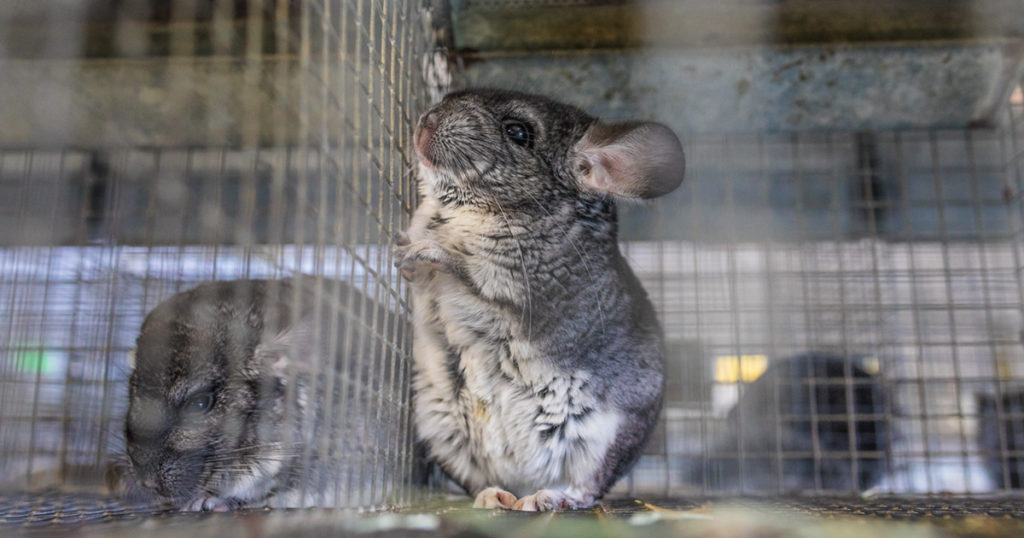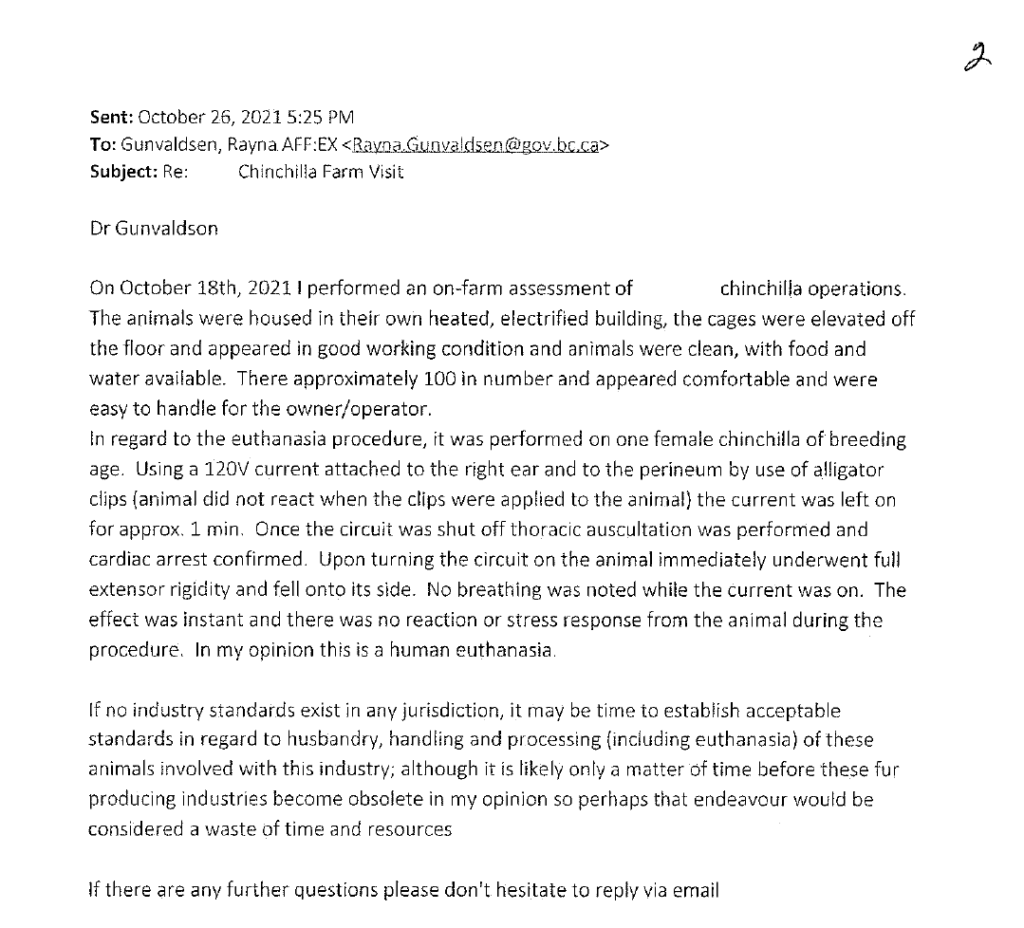
A judgment has been made on The Fur-Bearers’ judicial review regarding the BC government’s issuance of a fur farm licence to a chinchilla farm. Unfortunately, the Court has decided that the government’s decision to issue a licence to the fur farm without having a health management plan (HMP) in place was reasonable.
The Fur-Bearers is disappointed with the decision. However, in her judgment, Madam Justice Tucker had sided with The Fur-Bearers on issues related to standing, and rejected the government’s arguments that the issue was moot and not of public importance. Furthermore, the case has revealed disturbing information about the ‘euthanasia’ practices used to kill these chinchillas.
Click the button below to read the decision.
Case background and overview
In 2021, The Fur-Bearers filed a petition for judicial review after we learned that the BC Ministry of Agriculture issued a fur farming licence to a chinchilla fur farm that didn’t have a HMP in place. The HMP includes important information related to animal welfare, disease control, and other items that are necessary to have documented for a fur farm to operate in the province.
One of the core purposes of The Fur-Bearers is to uphold the administration and enforcement of animal welfare laws by monitoring the practices of commercial fur farms to determine compliance with relevant laws. This judicial review was the result of our work that sought to determine if this fur farm was in compliance with BC’s regulations. In response to the judicial review, the government argued that The Fur-Bearers lacks standing as the issue does not align with the organization’s central mission. On this point, the Court disagreed. (Note: The Fur-Bearers is referred to as AFPA (our legal name is The Association for the Protection of Fur-Bearing Animals).
In paragraph 62, Justice Tucker noted:
“The AFPA’s central mission is to protect the lives of fur-bearing animals. Its constitution speaks directly to monitoring fur farm practices. Although the AFPA does wish to see fur farms abolished, its central mission includes improving the quality of life and death experienced by animals while fur farms continue to exist. The treatment and euthanasia protocols required in an established HMP relate directly to that quality of life and death, and the issue sought to be raised involves enforcement of the Regime’s HMP-related provisions. The AFPA’s central mission does squarely align with the issue raised.”
The government also argued that the issue is moot and is not of public importance. The Justice rejected the government’s argument here as well. She notes at paragraph 51:
“I do not agree. The AFPA contends that on any reasonable interpretation of the relevant provisions of the Regime, the Chief Veterinarian’s discretion to grant a licence in the absence of an established HMP is at least restricted to exceptional circumstances. So framed, the issue raised does have systemic implications and could impact the issuance of licences in the future.”
When it came to the merits of the case however, Justice Tucker found that the issuance of the licence in the absence of a HMP was reasonable, arguing that an interpretation of the legislation suggests that a fur farmer does not need to have a HMP at all times, but that the Chief Veterinarian can work with licensees to establish a HMP after the licence is granted. The full discussion and reasoning begins at paragraph 65.
New information learned about the ‘euthanasia’ of chinchillas
One of the key drivers behind this case was to determine how these animals were being treated and killed, as the Ministry of Agriculture revealed through the FOI process that they have not developed any standards for the care, handling, and euthanasia of chinchillas. It was learned through the case that the method of euthanasia employed on this fur farm was via anal electrocution. An affidavit provided by the veterinarian who assessed the fur farm explained the process in detail.

The veterinarian notes, in suggesting that the government should establish standards of care and euthanasia for chinchilla fur farming, “. . . although it is likely only a matter of time before these fur producing industries become obsolete so perhaps that endeavour would be considered a waste of time and resources.”
Although the veterinarian deems anal electrocution as humane, we do not believe that public sentiment would agree with this characterization, nor does The Fur-Bearers accept that killing animals in this way is humane by any definition of the word.
Our Thanks
The Fur-Bearers want to express our deepest thanks and gratitude to our legal team and West Coast Environmental Law who provided financial support to help our legal challenge.
TAKE ACTION
Send a message to British Columbia’s Minister of Agriculture to express that fur farming of any animal is unacceptable. The email is AGR.Minister@gov.bc.ca.
Currently, only mink farming is banned in BC, but the chinchilla fur farm continues to operate in the province. The fur farming of five fur-bearing animals (foxes, martens, fishers, chinchillas, and nutrias) is still legally permitted in British Columbia.
Be polite and respectful when raising your concerns about fur farming to the Minister. Some points that can be included in your email:
- Acknowledging the work and thanking the ministry for taking action to prohibit mink farming.
- The Ministry of Agriculture should not accept any more applications for new fur farms and decline existing applications if there are any.
- The government should extend the prohibition on mink farming to all species.
- There are no provincial animal care standards or NFACC Codes of Practice developed for the fur farming of fishers, chinchillas, martens, or nutria.
- The practice of anally electrocuting chinchillas is inhumane and cruel.
- Fishers, martens, and foxes are all wild animals who make their home in British Columbia’s natural spaces. These animals should remain wild and free, not confined in small wire cages on industrial fur farms.
- Nutria are native to South America and are listed by the BC government as a “high risk” prohibited species. Allowing nutria to be kept on commercial fur farms risks these non-native animals escaping from fur farms and establishing themsleves in BC’s natural environment. Nutria are semi-aquatic animals and their natural habitats are marshes, wetlands, and other aquatic environments. Acquiring these animals from other countries will also contribute to the inhumane global wildlife trade and risks spreading dangerous pathogens across international borders.
- There is one chinchilla farm in British Columbia. The government should support this farm in transitioning to other sustainable and ethical industries.
- Fur farming is opposed by the majority of the public. A 2022 public opinion poll found that 81% of British Columbians would support a nationwide ban on fur farming.
For residents outside of British Columbia, visit our take action against fur farming page.
